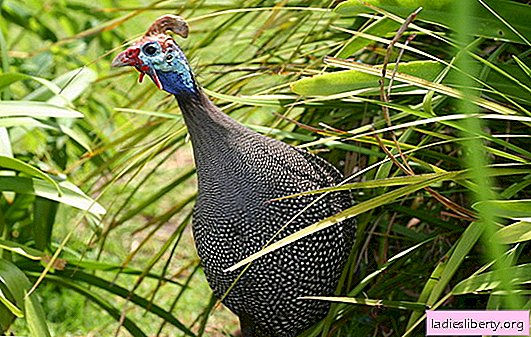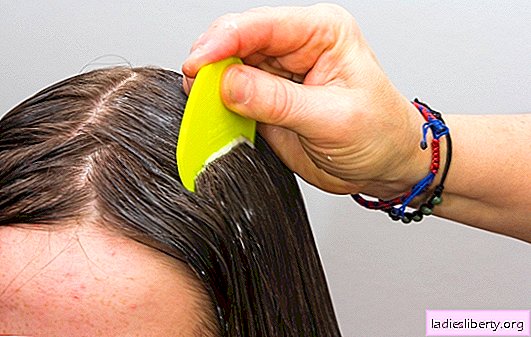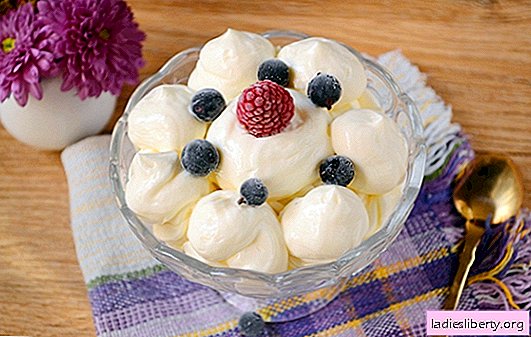
Beauty guinea fowl - a native of West Africa.
Guinea fowl are still rarely found in personal plots.
However, recently breeding and keeping guinea fowl at home is gaining more and more popularity.
In the vastness of Russia, this close relative of domestic hens, quails and turkeys feels great!
Guinea fowl is resistant to disease, completely unpretentious in maintenance. With good care, the guinea fowl can withstand even severe frosts.
Breeding and keeping guinea fowl at home: is it profitable?
The content of guinea fowls is advantageous in that they are much stronger and more durable in comparison with other breeds of poultry. For 1 kg of weight gain they need only 4 kilograms of feed. The breeds are considered especially valuable among amateur poultry farmers: gray-speckled, Volga blue, Siberian white, Zagorsk white-chested. Adult birds gain weight up to 1.5 - 2 kilograms.
This is very beneficial in some other respects:
Colorful appearance. The bird looks decorative, and Russian amateur poultry breeders turn them on to decorate the estate.
Meat. Low-fat and high-quality, reminiscent of the taste of game meat - partridge or pheasant. It is very nutritious, it contains up to 27% protein. According to its taste, it is recognized by consumers as the best of poultry meat.
Eggs are also tasty and healthy.. The weight of guinea fowl eggs is less than chicken, but they are twice as high in calorie content and vitamin content. Contain magnesium, lysine, manganese, carotene. Unlike chicken eggs, they do not cause allergies in children and adults. Having a thick strong shell, they are stored in the refrigerator for more than six months! Guinea fowl can lay up to 120 eggs during the year.
Precocity - young guinea fowl quickly gaining marketable weight. Birds can be sold already 45-50 days after they are born.

High stability in all climates. Adults successfully withstand winter frosts.
Guinea fowl in household plots plays the role of a fighter of harmful insects, slugs, worms. The only bird willingly eating Colorado beetles.
Guinea fowl like to roam the garden, but they behave in a civilized manner - they do not destroy the beds. You can’t just let them into the cabbage so that the heads of cabbage do not peel. In fields free from harvest, they destroy weeds, choose seeds. Satiated in the fields, guinea fowls sometimes do not eat evening food.
In summer, the best habitats of guinea fowl are gardens, shrubs, areas with dense grass.
Breeding and keeping guinea fowl at home: where to start?
Having decided to engage in the cultivation of guinea fowls, you should purchase daily healthy chickens. When buying, they pay special attention to the appearance of the chicks: an even soft fluff, clean buttocks; wings tightly pressed to the body. Guinea fowls confidently move on their paws. Healthy young animals actively react to sounds - if it is easy to knock on the box, they will make a noise.
For stable breeding of guinea fowls, it is better to purchase about 20 heads of birds in order to form a high-quality parent herd in the future. On the tribe, a bird is selected from 6 months of age. Distinguish males from females in a small bright tubercle directed upwards. In females, the tubercle is practically invisible.

Having bought young animals, they begin growing, breeding and keeping guinea fowl at home, observing certain rules:
The best time for the acquisition (breeding) and rearing of young animals from April to July. On the first day, chickens on wings are cut off daily chickens. This is done so that in the future well flying guinea fowls do not overcome the neighboring hedges.
Chicks are placed in a warm, dry room, where there are no drafts. The density of poultry should not exceed 10 animals per 1 square meter.
Chicks are not recommended to be kept in cages from a net so as not to injure them.
Arrange the required number of perches - 5 guinea fowls are placed per 1 running meter. The bird should not sit on the floor. The floor is covered with dry litter, which is changed once a month.
In winter, the bird is provided with additional electric lighting (from 7 a.m. to 10 p.m.).
Breeding and keeping guinea fowl at home: what is needed for this?
Each cage must be equipped with a feeder and a drinking bowl. Fresh clean water should always be poured into the drinker. This is especially important in the summer so that the birds do not experience heat stroke.
Cleanliness is an indispensable condition that affects the breeding and maintenance of guinea fowl at home and for this they must always clean drinkers, feeders and cages in a timely manner. Disinfection in the room is carried out once a month regularly.
Freelance guinea fowl by nature, require a lot of space: without this, the growth of birds slows down, they begin to rush less. You can not mix guinea fowls of different subspecies so that they do not start to fight among themselves, competing for food.
For guinea fowl, special platforms are equipped - well-lit places, here they go to soak up the sun. Shaded areas should also be in the aviary. On walking the birds, it is advisable to plant thick grass and shrubs, having built a small canopy from the rain.
The state of young animals is judged by some signs of the behavior of the chicks. If the room is cool, guinea fowls are knocked into flocks. If they lie with their beaks open and their wings spread relaxed - it’s hot in the room, the temperature must be lowered.
For a walk, chicks begin to be released at the age of 2-3 months. This gives them the opportunity to learn to independently seek out food, getting any larvae, bugs and worms in the ground. In the enclosure, there must certainly be a feeder and a drinking bowl with fresh water. In the evening, all guinea fowls return home to feeding before dusk.
Features feeding guinea fowl
In the first week, guinea fowl diet includes mixtures of crushed egg yolk, green onion and cottage cheese. Watered with whey or yogurt. Wonderfully grow chicks from sprouted wheat chopped in a meat grinder!
From the 2nd week it is possible to transfer chickens to “pasture” feed: clover greens, ordinary grass, nettles, alfalfa. Initially, the chicks are fed 8 times a day. When they grow up to a month, they switch to 5 single feeding. And from 2 months of age, chickens are fed 3-4 times a day.
Guinea fowls require a lot of water for stable growth. First, the feed is soaked with water so that it is better absorbed and not choked on with dry food.
Adult guinea fowls are fed several times a day. It is great if there is always fresh food in the feeders. Then the birds will feed on demand
Guinea fowl in nutrition are the most unpretentious bird, they eat literally everything - feed, root crops, vegetables and fruits, food waste, grass.
Favorite "dishes" guinea fowl - insects, snails, worms. Therefore, experienced poultry farmers believe that breeding and keeping guinea fowl at home provides for the most varied diet of birds.
Guinea fowls are known to be the main enemies of the Colorado potato beetle in the garden. But poultry farmers recommend preparing guinea fowl for this in a special way. First, the owner himself collects bugs, grinds them, mixing with the main feed. Repeating this procedure for a week, gradually increase the number of beetles in the diet. Then give the bird whole beetles. After such a procedure, guinea fowls themselves will actively seek out and destroy pests on the site.
Guinea fowl, whose popularity on farms is increasing, spend most of their time on pastures. Therefore, especially in the summer, it is very beneficial to maintain them. In the cold period, the bird is fed more thoroughly, adding meat wastes, yogurt, fish oil to the moist mixers. In the evening they give grain and mixed feed. In comfortable conditions, guinea fowl rush year-round.
Breeding and keeping guinea fowl at home: the main problems
Guinea fowl are late-ripening birds, as adults mature, eight months after birth.
Guinea fowl chicks hatch after 27 days from the start of hatching or incubation of eggs. When starting breeding and keeping guinea fowl at home, it should be borne in mind that these wonderful birds are rather shy. They react violently to the slightest movement or loud rustling. And mothers from them for this reason turn out very bad. Guinea fowls are intolerant of the education of future offspring. And often they run away from the nest before the babies.
It is better to remove the chicks in an incubator, or lay the eggs under a more reliable brood hen: turkey, chicken or turkey.
Breeding and keeping guinea fowl at home: a pleasant business
At a young age the guinea fowl is a very nimble bird. Quickly eats food, scandal with relatives. Therefore, young growth should be fed from a convenient oblong feeder in small portions. This will allow access to feed the entire flock of birds and ensure its complete eating.
In addition to the hassle, breeding and keeping a guinea fowl at home gives the owners of these magnificent birds a real pleasure. Birds know their flock very well, always keep in a group. Accustomed to the owner, they recognize him by their voice and, with his arrival in the house, they raise an incredible whine. The excessive loudness of guinea fowls can be considered the only minus.
However, when foreign dogs or strangers appear on the estate, the birds make a real commotion. The most reliable watchmen are made of them!
Guinea fowls, like chickens, love to swarm in the ground, looking for different animals. Therefore, it is wise to sprinkle a heap of ash and sand on a bird's walk so that the birds bathe in it.
Breeding unusual guinea fowl is not only a fascinating activity, but also brings a decent profit for the farmyard.
Good luck and good health!











